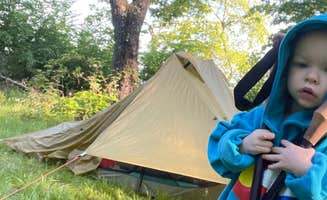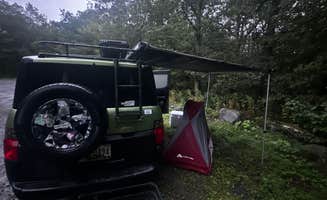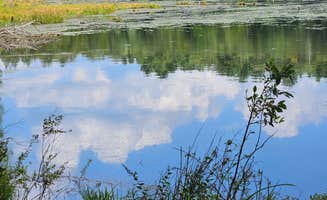Primitive camping near Andover, New Jersey offers several backcountry options within a 50-mile radius spanning three states. The surrounding Delaware Water Gap National Recreation Area encompasses over 70,000 acres with elevations ranging from 300 to 1,600 feet above sea level. Most dispersed campsites in the region require self-sufficiency with no facilities and variable seasonal closures from November through April depending on weather conditions.
What to do
Hiking opportunities: The Thunder Swamp Trailhead in Pennsylvania connects to an extensive network of trails. "Trailhead parking was chill for a night. No trouble. Tons of hiking. Went down Saw Creek trail to a marsh," notes camper Jason R. This location serves as a convenient base for day hikes with multiple trail options.
Hammock camping: The Appalachian Trail Designated Backpacker Campsite 2 in Columbia offers ideal hammock camping terrain. According to Katharine T., "We camped nearer to others but there are secluded spots too. Well maintained w bear boxes provided. Good trees for hammocking." The site features various camping configurations for those who prefer hanging systems over ground tents.
Lakeside camping: Hickok Brook in New York provides waterfront camping opportunities with basic amenities. Gregg T. reports, "Really is a nice quiet place. It's Labor Day weekend, see how many people try to cram in to the very limited camping area." The lake offers swimming during summer months but requires appropriate permits from the New York State Rangers office.
What campers like
Bear management systems: At Appalachian Trail- Designated Backpacker Campsite 2, campers appreciate the safety infrastructure. "Well maintained w bear boxes provided," notes Katharine T., highlighting an important feature for food storage in bear country that helps protect both wildlife and campers.
Privacy options: The balance between community and solitude draws campers to certain sites. "We camped nearer to others but there are secluded spots too," reports Katharine T. about the Appalachian Trail site, indicating flexibility for different social preferences within the same camping area.
Accessibility: Some sites offer straightforward parking options. Benjamin H. describes Thunder Swamp Trailhead as "a gravel parking lot. Plenty of shade. No one bothered me," indicating a simple, low-maintenance base camp option for overnight stays with vehicle access.
What you should know
Water planning: Water access varies significantly between sites. Katharine T. notes about the Appalachian Trail site: "No Water (nearest is sunfish pound- easy hike about a 1 mile round trip)." Campers must bring sufficient water supplies or plan filtration from available natural sources.
Permit requirements: Many dispersed camping areas require permits that must be obtained beforehand. Gregg T. at Hickok Brook learned this firsthand: "Where I originally camped was not a spot, according to Ranger. Had to move next to the lake. Need a permit on NY state land. Contact Rangers office of whatever county." Always check with the managing agency before arrival.
Road conditions: Access roads to primitive sites often present challenges. Corey describes Hickok Brook access: "The road is very rough with huge potholes so good clearance is a must. It's not a good spot for car camping but you could conceivably drive up to the spots and pull off the road to put up a small tent somewhere."
Tips for camping with families
Limited space awareness: Several dispersed sites have strict capacity constraints. At Hickok Brook, Gregg T. observes, "There are only 3 spots where we are. No motor vehicles beyond where I'm camping." Families should arrive early, especially during peak season or holidays.
Supply planning: Remote locations require comprehensive planning. "Bring everything with you. It's a hike back to town... there is a small town 10 minutes away. Eldred, NY," advises Gregg T. about Hickok Brook. Families should pack extra supplies, including food, water, and first aid materials.
Site selection for tents: Some areas present challenges for traditional tent camping. Renee Z. notes about Appalachian Trail camping, "It's a little on the small and sloped side for tent camping, but I was in a hammock and it was a great place for that!" Families should bring equipment suitable for potentially uneven terrain.
Tips from RVers
Vehicle limitations: Most dispersed camping areas near Andover have significant vehicle restrictions. Corey's experience at Hickok Brook is typical: "I drove in thinking that there would be flat places to park a very rugged camper in my full ton diesel pickup. The road is very rough with huge potholes so good clearance is a must. It's not a good spot for car camping." High-clearance vehicles are required for many access roads.
Size restrictions: RV camping options are severely limited in this region's dispersed sites. "Very gorgeous but not RV friendly," Corey reports about the Hickok Brook area, confirming that most primitive camping near Andover is unsuitable for larger vehicles or trailers.
Alternative parking: For those with larger vehicles, some trailheads provide basic overnight parking. Benjamin H. describes Thunder Swamp Trailhead as simply "a gravel parking lot. Plenty of shade. No one bothered me," which could accommodate smaller camper vans or truck campers for basic overnight stays.




